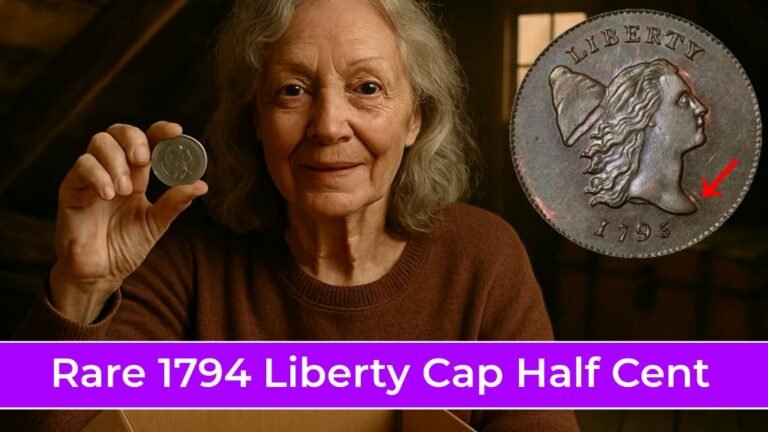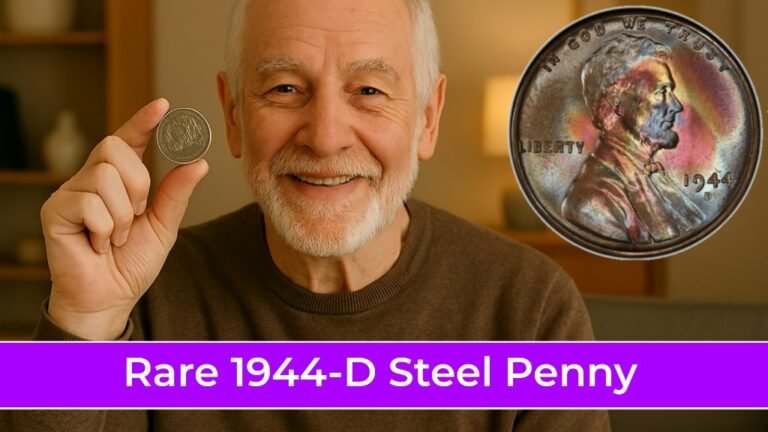7 Rare Lincoln Pennies – While most Americans see pennies as mere pocket clutter—barely worth a second glance—serious collectors and lucky finders know that some Lincoln cents are worth far more than their one-cent face value. In fact, a handful of rare Lincoln pennies can be worth thousands, even millions, of dollars. From wartime production errors to minting mistakes that defied the odds, these seven rare pennies are the holy grail of U.S. coin collecting.
If you’ve ever dug through an old coin jar, sorted change from a coffee can, or inherited a relative’s dusty collection, you might just be sitting on a small fortune.
Here’s a look at the seven most valuable Lincoln pennies—and what makes them so special.
1. The 1943 Copper Penny
During World War II, the U.S. Mint switched from copper to zinc-coated steel for penny production to conserve copper for military use. So, when you see a 1943 penny, it should be steel—and magnetic.
But here’s the twist: a small number of 1943 pennies were accidentally struck on leftover copper planchets. These rare copper 1943 cents are among the most famous error coins in American history. Only about 40 authentic specimens are known to exist.
How to spot it: If your 1943 penny is not magnetic, it could be the real deal. One such coin sold for over $1 million in 2012. Authenticating it through a service like PCGS or NGC is essential—counterfeits are common.
Also read – Top 10 Most Valuable American Silver Eagles
2. 1909-S VDB Penny
The Lincoln penny debuted in 1909 to honor the 100th anniversary of Abraham Lincoln’s birth. Designed by Victor David Brenner, early versions featured his initials “VDB” prominently on the reverse, below the wheat stalks.
Public backlash led the Mint to quickly remove the initials—but not before 484,000 1909-S VDB pennies were minted in San Francisco. That low mintage makes them highly desirable.
Value: Even in average circulated condition, this coin can fetch $700 to $1,000. Uncirculated specimens have sold for over $100,000, especially in top grades.
3. 1914-D Penny
With a mintage of just 1.2 million, the 1914-D Lincoln penny is one of the key dates in the Wheat Penny series (1909–1958). Minted in Denver during a time when coin production was inconsistent, this penny is a prized find for collectors.
Why it’s valuable: Its scarcity and historical significance make it a standout. A well-preserved 1914-D can sell for $2,000 to $10,000, with top-tier examples exceeding $50,000.
4. 1922 No “D” Penny
Most pennies from the Denver Mint have a clear “D” mintmark. But in 1922, overuse and poor die maintenance caused some coins to be struck so weakly that the “D” disappeared entirely.
These 1922 No “D” pennies come in several varieties—some show a faint “D,” others have none at all. The cleanest examples, where the mintmark is completely missing, are extremely rare.
Value: Depending on the variety and condition, prices range from $1,000 to over $15,000. Certified, high-grade specimens are true collector’s items.
Also read – Top 7 Most Valuable Jefferson Nickel Error Varieties
5. 1955 Double Die Obverse Penny
The 1955 doubled die obverse penny is arguably the most famous U.S. error coin. Due to a misaligned hub during die creation, the date, inscriptions, and Lincoln’s portrait appear doubled—most noticeably in the words “LIBERTY” and “IN GOD WE TRUST.”
Only about 20,000 to 24,000 were released into circulation before the Mint caught the error.
Value: Even heavily worn examples can sell for $1,000 or more. Uncirculated specimens have reached $25,000+ at auction.
6. 1931-S Penny
During the Great Depression, demand for coinage dropped sharply. The San Francisco Mint responded by drastically reducing production. The 1931-S Lincoln cent, with a mintage of just 866,000, is one of the lowest in the entire Wheat Penny series.
Because so few were made, even circulated 1931-S pennies are valuable. Finding one in mint condition is exceptionally rare.
Value: Circulated coins start around $100–$300, while uncirculated specimens can reach $5,000 to $15,000 depending on grade.
7. 1969-S Double Die Obverse Penny
After the Mint corrected the 1955 error, doubled dies became much rarer. But in 1969, a similar mistake occurred on a San Francisco proof penny. The 1969-S doubled die obverse shows clear doubling in the inscriptions and Lincoln’s cheek.
Fewer than 30 authentic examples are known, and many have been hoaxed. Genuine coins are authenticated only after rigorous inspection.
Value: A certified 1969-S doubled die penny can sell for $30,000 to $100,000+, making it one of the most valuable modern U.S. cents.
Why Are These Pennies So Valuable?
Three main factors drive the high value of rare Lincoln pennies:
- Rarity: Low mintage numbers or production errors make these coins scarce.
- Condition (Grade): A coin’s state of preservation dramatically affects its value. Professional grading by PCGS, NGC, or ANACS can confirm authenticity and boost price.
- Historical Appeal: Stories behind these coins—wartime shortages, design controversies, accidental errors—add emotional and educational value that collectors cherish.
How to Find a Rare Lincoln Penny
You don’t need to be a professional numismatist to find treasure. Here’s how to start your search:
- Check your change daily. It’s unlikely, but rare coins do still circulate.
- Dig through old coin jars, drawers, or inherited collections. Family heirlooms are a common source of rare finds.
- Learn key dates and mintmarks. Focus on years like 1909, 1914, 1922, 1931, 1943, 1955, and 1969.
- Use a magnifying glass or jeweler’s loupe. Look for doubled letters, missing mintmarks, or unusual metal color.
- Get coins graded. Never clean a potentially valuable coin—send it to a reputable grading service instead.
- Join a coin club or online forum. Communities like the American Numismatic Association (ANA) offer support, education, and networking.
Final Thoughts
While most Lincoln pennies are worth just one cent, these seven rare versions prove that small coins can carry massive value. Whether you’re a seasoned collector or a curious beginner, the thrill of discovery is real—and so is the potential payoff.
So the next time you hear the clink of change in your pocket, take a closer look. That old copper penny might not be junk. It could be a piece of history—and a ticket to financial freedom.




